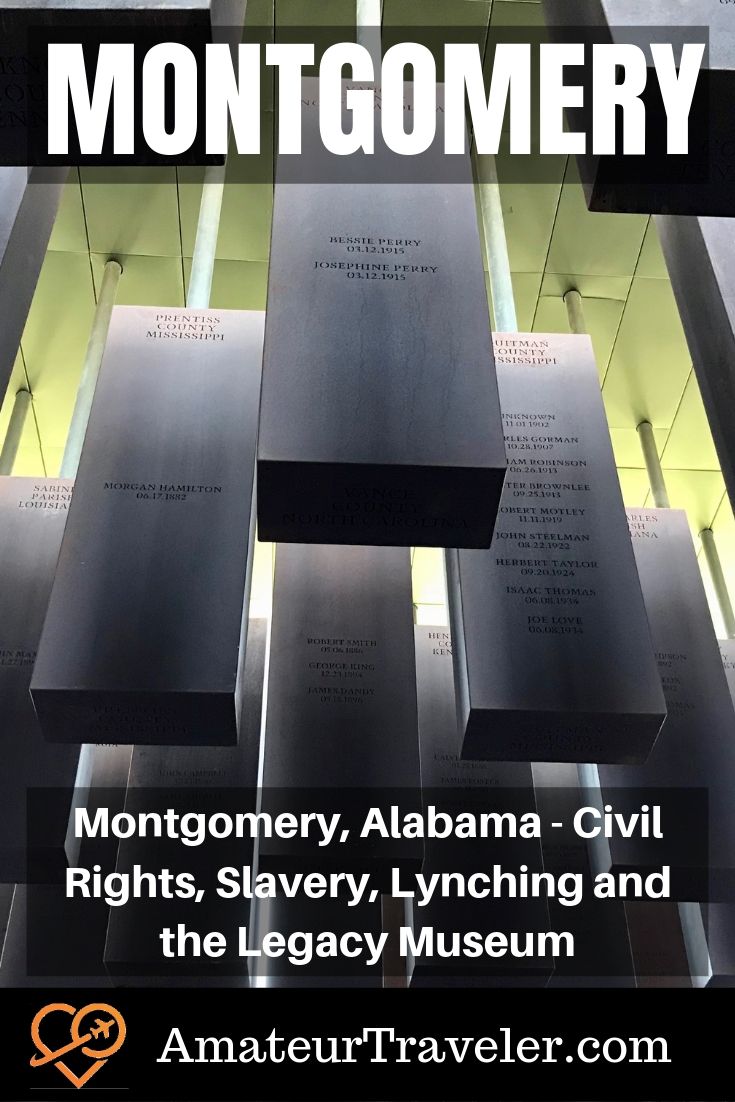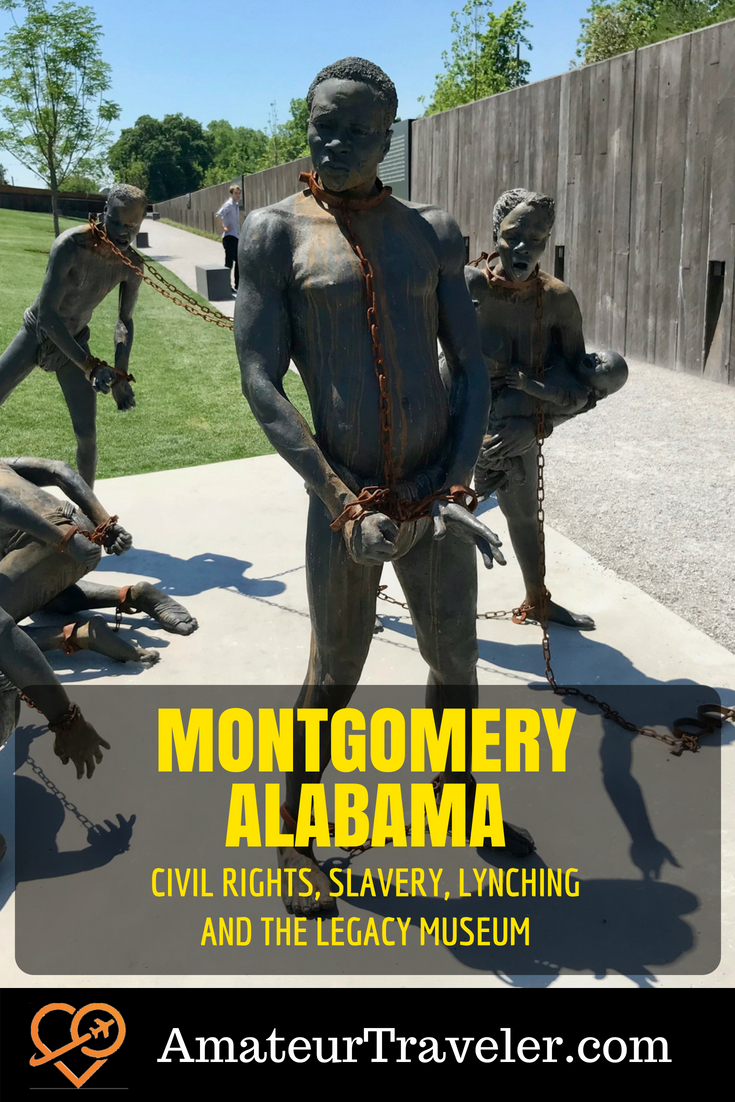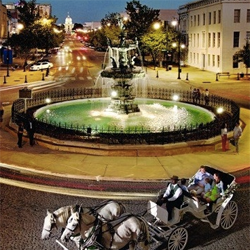Montgomery, Alabama – Civil Rights, Slavery, Lynching and the Legacy Museum (Video #98)
categories: USA TravelI was recently in Montgomery Alabama for the opening of the new Legacy Museum and the Memorial to Truth and Justice (the “lynching memorial”). The Legacy museum documents the history of African Americans from “Enslavement to Mass Incarceration”. This is a great start for a trip to Montgomery highlighting the history of civil rights.
Table of contents: ()
History

The fountain is at the site of a spring, where two towns (New Philadelphia and West Alabama) merged to become Montgomery. They chose the name Montgomery after General Richard Montgomery who died in the Revolutionary War in the battle of Quebec.
Where the fountain now sits was the town’s market. It is where, among other things, people bought and sold the area’s two most important products: cotton and the slaves that could grow cotton.
Civil War
To your right, down Dexter Avenue, is the Alabama capital building which was also the first capitol building for the Confederacy. On its steps, Jefferson Davis took the oath of office.
Across the street on the left where a tall bank building now stands was the site in 1861 of the Exchange Hotel where delegates debated the decision to fire on the Union troops in Fort Sumter. When that fateful decision was made, it was issued from the building behind you which was the telegraph office.
Civil Rights
In 1955, at the start of what would be a different battle, a tired seamstress named Rosa Parks came out of one of the buildings to the right and boarded a bus at the corner in front of you. Two blocks to your left, she was arrested for not giving up her seat to a white man when the driver told her to.
Word spread about the arrest and a call went out for a one-day bus boycott the following Monday. A meeting was held down the street on your right, just in front of the capital at the Dexter Avenue Baptist Church on Monday and it was decided to continue the boycott. The need was felt to organize the boycott so the MIA (Montgomery Improvement Association) was formed. The church pastor, 26-year-old Martin Luther King, was asked to lead the group in what turned into more than a year-long strike and also turned into the start of the modern Civil Rights Movement.
That struggle would last more than a decade. It was on those same capitol steps that Governor George Wallace would proclaim ”segregation today, segregation tomorrow, segregation forever.”
But also down this same street, would come a group of marchers in 1965 from Selma. They were led by Dr. King and came right past the spot where Rosa Parks was arrested, right past the site of the former slave market, right past the church, and up to the same steps of the capitol building to peacefully protest for voting rights.
This is the legacy of Montgomery. Not slavery or freedom, not war or peace, but both.
The Legacy Museum
Slavery
A new museum has recently opened in Montgomery, just a few blocks from where we started our tour, to remember some of that legacy, or at least one thread of that legacy. The museum was created by EJI, the Equal Justice Initiative. It is housed in a building that once housed slaves who were to be sold at the local slave market.
When you enter the museum you start your journey with the story of slavery in the south in general and in Montgomery specifically. You walk past cells where videos show slaves who are lamenting the separation of loved ones “sold down the river”. Over half of the families of slaves were split up at some time.
You will learn about the economics of slavery and the domestic slave trade, slave revolts, and eventually the end of slavery.
- Get a Car Rental
- Search for Great Tours HERE
- Buy Travel Insurance
- Book Your Accommodation HERE

Freedom?
But then you learn not about freedom but a new form of slavery because the new clauses against slavery exempted prisoners. Many a young black man was arrested, sometimes on trumped-up charges, and sentenced to chain gangs that were leased out by the government. These convicts were in many ways treated worse than slaves. If a slave was your property then he or she had some value. Convicts could be replaced easily. In some counties as high as 20-40% of convict labor would die in a given year.
Terror
The museum also documents the history of lynchings that were used to terrorize the black population who at the end of the Civil War had greater numbers in the Deep South states like Alabama. The museum documents not just when people were killed by mob “justice” without trial or investigation, but also when people were killed for protesting someone being lynched or for the simple act of voting.
The museum has a collection of soil from around the country from the 800 different counties where they have documented lynchings.
War on Drugs
When Richard Nixon declared a war on drugs in 1971, the victims in this war were disproportionately black. The average rate of incarceration from 1925 to 1972 in the United States was 110 per 100,000 people. By 2012 that grew to 707 per 100,000 people. The United States has the largest prison population in the world, and the second-highest per-capita incarceration rate, behind the Seychelles
The museum also draws a line from slavery, through convict labor to modern times when one in every 3 black boys can expect to be incarcerated at some time in their lives. It tells a story about an ongoing search for justice that is the mission of the Equal Justice Initiative.
The last part of the museum deals with answering the question, “what can I do about it?”
The museum is well presented and sobering. I think it is a museum that is best to tour with a group. Take in the museum alone at your own pace, but it is a museum that will lead to discussion.
Memorial to Truth and Justice
On a hill overlooking Montgomery, within easy walking distance from Market Square, at the same time that the Legacy Museum opened, EJI also constructed the moving Memorial to Truth and Justice which you may also hear called the Lynching Memorial.
The Memorial has 800 steel monoliths suspended from the ceiling. Each monolith is inscribed with the name of one particular county in the USA which has at least one documented case of lynching from reconstruction to 1952. Each bears the name or names of the victims when the names were known.
Outside the memorial, each monolith has a twin that is waiting to be taken home and displayed by the county inscribed on it. It will be interesting to see which counties claim this dark heritage. Montgomery has. The land for the memorial was purchased from the city and the city has helped with the promotion of both the museum and memorial.
Rosa Parks Library and Museum
After you have toured the Legacy Museum and the Memorial to Truth and Justice, I would suggest walking back down to Dexter Avenue, where two blocks from where we started, at the spot where Rosa Parks was arrested is the Rosa Parks Library and Museum.
This museum does a wonderful job of explaining the Montgomery Bus Boycott and the start of the Civil Rights Movement. It is very well presented. After an opening video, you walk into a room with a full-sized bus. While you look into the windows of this bus the whole drama unfolds again. It is quite effective. Subsequent rooms explain the “demands” of the boycott if such limited goals could be called demands:
- Be treated with dignity
- Not have to give up the seats in the back
- Hire some black drivers
They did not even ask for bus desegregation, although that is eventually what they ended up with at the end of more than a year-long strike.
The museum also documents the vigorous and sometimes violent actions against the boycott as well as the organization of carpools and other strategies.
The Dexter Avenue King Memorial Baptist Church
If you can arrange your schedule to visit the church, which now bears Dr. King’s name, you should. Save this for last, because if you feel like you need a hug after all the dark history you are processing this is where you will… quite literally… get one.
The church has a tourism ministry that starts in the basement where Dr. King’s office was and where the meetings to organize the bus boycott took place. You will learn about the locals, including not a few church members, who took part in the boycott and in the civil rights movement.
Our tour ended holding hands and singing. Suffice it to say, this is not a typical tour.
Conclusion
Alabama was a state that, I have to admit, I had some reluctance to visit. I grew up in the 1960s and watched the civil rights struggle unfold at night on the nightly news. It all seemed so completely foreign to my experience as a young white boy growing up in California.
My first visit to Alabama was a year and a half ago and this was now my third visit to a state that I have, somewhat to my surprise, come to love. Visiting the civil rights sites like these is something I think Americans of all hues should do, but don’t limit your visit to this Montgomery of the past. Also, take time to explore the Montgomery that is still in progress. It is a city that has owned its legacy but is choosing to build a new one as well.
+Chris Christensen | @chris2x | facebook
9 Responses to “Montgomery, Alabama – Civil Rights, Slavery, Lynching and the Legacy Museum (Video #98)”
Leave a Reply
Tags: alabama, article, civil rights, featured, Montgomery, museum, video travel podcast










 11 Things to Do in Montgomery Alabama
11 Things to Do in Montgomery Alabama Civil Rights Sites You Should Visit in the USA
Civil Rights Sites You Should Visit in the USA Montgomery, Alabama – On the Move from Past to Present
Montgomery, Alabama – On the Move from Past to Present 16 Great Places to Eat or Drink in Montgomery Alabama
16 Great Places to Eat or Drink in Montgomery Alabama

Kemi
Says:June 16th, 2018 at 9:25 pm
Sigh…where does one begin? America tries to forget her horrible past or tell descendants of enslaved Africans to just “get over it”. Sigh. I saw videos of actual lynchings and the grandchildren (now grandparents themselves) of lynched men narrating stories passed down of their murdered kin. Chilling. I’m not sure I can even visit. I know that such things fill me with rage and sorrow for those wo were part of it. Well done and thank you for writing this post.
Chuck
Says:June 17th, 2018 at 7:40 pm
I lived in Montgomery for three years. That city has a lot of history. That city could be so much more than it is.
Susan
Says:June 18th, 2018 at 1:09 pm
Earlier this month I visited the Civil Rights Museum in Memphis. This looks like a similarly moving experience.
chris2x
Says:June 18th, 2018 at 6:33 pm
Very much so. The Civil Rights Museum in Memphis is probably my favorite museum in the country, but this one is also great. On a smaller scale the Rosa Parks museum is great too.
Robert Kamau
Says:July 14th, 2018 at 5:21 am
I would love to visit the Alabama civil rights museum and learn in real life of the slave era in america. Most of us only see it in the movies and tv series like Roots etc. Its truly a past that cannot be unlived.
chris2x
Says:July 14th, 2018 at 8:01 am
It is worth seeing, even if it is a difficult and shameful part of our history.
EjLynch
Says:March 20th, 2019 at 12:55 pm
I’m planning a family trip this spring so that my grandchildren can get a feel of our real history in this country especially our southern roots. The truth of our past is long over due for the telling. All birth is painful but worth it in the end. Something new is born.
Chris Christensen
Says:March 20th, 2019 at 5:46 pm
There is much to see, but also do take time to enjoy the good as well. Take in a biscuits baseball game fo instance.
Brandon Sigauke
Says:November 25th, 2019 at 5:54 am
From the images,it shows that all parts of slave trade are explained there ..I wish to visit this place soon